How To Increase Life of the Tyre ?

The Most Important Factors of safe Vehicle operation is systematic and correct tyre maintanance. The life of the Tyre Depands Basically on the Care we take
- Tyre Inspection
- Overloading
- Wrong loading
- Over-inflating Tyre
- Correct Air Pressure or Tyre Pressure.
- Under-Inflation
- Bleeding of tyres
- Matching of tyres
- Mechanical Foults
- Regular Wheel Alignment. & Balancing
- Tyre Rotation.
- Uneven Wear Pattern.
- Damaged Sidewall.
Tyre Inspection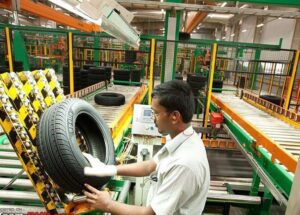
Regular inspection and maintenance of your tyres will help prolong their lifespan. The condition of your tyre tread is one indicator of your vehicle’s health. Regular checks of all four tyres can help diagnose potential problems that may require professional intervention. Inspect your tyres at least once a month, as well as before and after long journeys.
Overloading
Vehicle Should be Loaded to the extent of tis capacity fixed by the manufacturer . in case it is overloaded, over and above fast wearing of other parts , the tyre useless. as such the vehicle should always be carrectly loaded
Wrong Loading
While loading the vehicle specially trucks, care should be taken to place the load in the center of the body. load in no case should Be kept at rear or frant or on one Tyre only as it will couse that tyre run hot and fail prematurely.
Correct Air Pressure.or Tyre Pressure
It’s recommended that you get your tyre pressure checked every two weeks, including that of the spare. This is important as improper inflation can result in uneven wear of the tyre surface. Also, wrongly inflated tyres have a higher chance of bursting when running on highways. Make sure that you get the tyres checked when they are cold. The recommended tyre pressure is usually mentioned on the driver-side door sill and in the owner’s manual.
- Tyre Pressure: Make it a habit of checking tyre pressure regularly (every 2-4 weeks) as proper tyre inflation can make driving a lot safer and make your tyres last longer. Always maintain Inflation Pressure (cold) within recommended parameters. Even in ideal conditions, tyres lose pressure at a rate of about 0.69 bar or 1 pound per square inch (psi) per month. That rate increases as temperatures rise. You’ll find the recommended pressure in your vehicle owner’s manual or on the sidewall of your tyre. Maintain 5 psi(0.3 kg/cm2 ) more pressure than recommended in the spare wheel and correct it once it’s put to use.
Under Inflation
A tyre that is underinflated causes the casing ply to over flex. This over flexing can lead to a rupture of the casing ply and subsequent rapid air loss. This condition is commonly referred to as a zipper rupture.
Any tyre with a pressure of 4 psi/0,28bar or lower, should be checked thoroughly for penetrations, valve leakage, or wheel damage which may account for the pressure loss.
Any tyre that has run 20% below the recommended pressure should be considered flat. The tyre should be removed and demounted for a complete inspection of the interior. If signs of run-flat damage are present, the tyre should be scrapped.
OVER INFLATION
Over-inflation results in an under-deflected tyre carcass. The tread is more rounded, concentrating tread wear in the centreline area. Traction is reduced in high torque service because ground contact of the tread shoulder area is reduced and the harder carcass – with reduced flexing characteristics – does not work as efficiently. In addition, the tightly stretched over-inflated carcass is more subject to weather checking and impact break damage.
More tyres go out of service prematurely from under-inflation than for any other reason.
Matching of tyres
Un Trucks and Buses Where Dual Wheels Are fitted on the Rear axle, the height of both the tyre should be the same . In the same.
MECHANICAL FOULTS
Any Defect in vehicle Specially in steering system accelerate tyre wear. a good mechanic can find out the fault in the system by checking tyre wear patterns. excessive tyre wear due to mechanical defect
- Toe in or toe out defective.
- wrong setting of camber angle
- wrong setting of caster angle
- bent front axle
- bent chassis
- grabbing pf brakes
- worn out hub bearing
Regular Wheel Alignment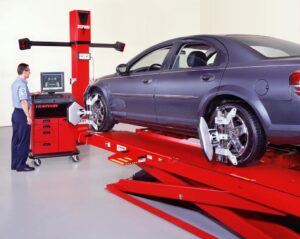
Wheel alignment is the calibration of suspension and tie-rod settings. If your car is pulling to one side or suffering from uneven tyre wear, or there are vibrations in the steering, getting your wheels aligned can fix those issues. Steering vibrations can also be due to an unbalanced tyre. To balance it, the wheel is rotated at a high speed to check if there’s an imbalance. Weights are then added to the rim to balance it out. It is recommended to balance your tyres every 10,000km.
- Wheel Alignment: Wheel alignment should be done after every 5,000 kms. or whenever any irregular wear on tyre is found.
- Wheel Balancing: Wheel balancing allows the tires and wheels to spin without causing any vibrations. This is recommended for better ride, handling and safety. Balance the wheel assembly whenever vibrations are felt during running
Tyre Rotation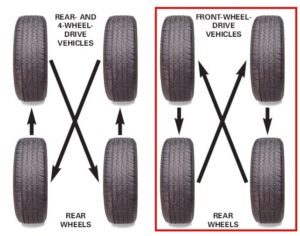
Rotating tyres is the best way to have equal wear across all tyres and thus extend their service life. The rotation of tyres depends on the type of vehicle, i.e. front-wheel drive, rear-wheel drive or four-wheel drive. Wheel rotation is recommended every 10,000km
- Tyre Rotation: Ensure that your tyres wear evenly by having them rotated every 5000 kms. Rotating your tyres helps achieve uniform wear across the full set. Even wear can help extend the life of your tyres and obtain balanced handling and traction. Regular tyre rotation can help keep your vehicle handling smoothly. It’s a good idea to rotate them at every second oil change.
Tyre Replacement
Tyre life varies. It depends on your driving habits, the climate you live in and how well you maintain your tyres. All tyres wear out or become damaged and will eventually need replacing. Always replace tyres once tread wear indicator is visible
CONSTITUENTS OF A TYRES
- Rubber:- Natural or Synthetic- Compounded With a large Number of chamical to ensure the necessary characteristics
- Nylon or Rayon Cord fabric For The Tyre Body
- Steel For high Tensile Steel Bead Wires
TYRE PROPERTIES
- Non-Skidding.:- The tyre Should not skid or slip on the Road Surface. it Should have Good Grip.
- Uniform Wear:- The tyre Must get Wear Uniformly over its Outer circumference
- Load Carring:- The tyre Should Be able to absorb Vibrations Set-Up By the Road surfaces. Thus Providing cushioning effect
- Power Consumption.:- While rolling on the road the tyre should consume least power developed by the engine.
- Noise:- The tyre should be balanced Dynamically as well statically.
Tyres Maintenance
 Tyre Inspection: Regular inspection and maintenance of your tyres will help prolong their lifespan. The condition of your tyre tread is one indicator of your vehicle’s health. Regular checks of all four tyres can help diagnose potential problems that may require professional intervention. Inspect your tyres at least once a month, as well as before and after long journeys.
Tyre Inspection: Regular inspection and maintenance of your tyres will help prolong their lifespan. The condition of your tyre tread is one indicator of your vehicle’s health. Regular checks of all four tyres can help diagnose potential problems that may require professional intervention. Inspect your tyres at least once a month, as well as before and after long journeys.
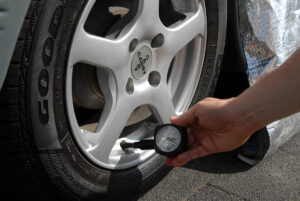 Tyre Pressure: Make it a habit of checking tyre pressure regularly (every 2-4 weeks) as proper tyre inflation can make driving a lot safer and make your tyres last longer. Always maintain Inflation Pressure (cold) within recommended parameters. Even in ideal conditions, tyres lose pressure at a rate of about 0.69 bar or 1 pound per square inch (psi) per month. That rate increases as temperatures rise. You’ll find the recommended pressure in your vehicle owner’s manual or on the sidewall of your tyre. Maintain 5 psi(0.3 kg/cm2 ) more pressure than recommended in the spare wheel and correct it once it’s put to use.
Tyre Pressure: Make it a habit of checking tyre pressure regularly (every 2-4 weeks) as proper tyre inflation can make driving a lot safer and make your tyres last longer. Always maintain Inflation Pressure (cold) within recommended parameters. Even in ideal conditions, tyres lose pressure at a rate of about 0.69 bar or 1 pound per square inch (psi) per month. That rate increases as temperatures rise. You’ll find the recommended pressure in your vehicle owner’s manual or on the sidewall of your tyre. Maintain 5 psi(0.3 kg/cm2 ) more pressure than recommended in the spare wheel and correct it once it’s put to use.
 Wheel Alignment: Wheel alignment should be done after every 5,000 kms. or whenever any irregular wear on tyre is found.
Wheel Alignment: Wheel alignment should be done after every 5,000 kms. or whenever any irregular wear on tyre is found.- Wheel Balancing: Wheel balancing allows the tires and wheels to spin without causing any vibrations. This is recommended for better ride, handling and safety. Balance the wheel assembly whenever vibrations are felt during running
- Tyre Size: For optimum radial advantage, mount tyres with recommended rim width.
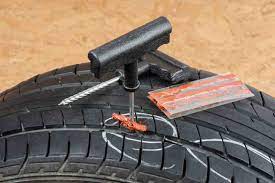 Post Puncture maintenance: Check tyres thoroughly for damages due to punctures and impact. Always use new tubeless valves and new tube while replacing the tubeless and tube type tyres
Post Puncture maintenance: Check tyres thoroughly for damages due to punctures and impact. Always use new tubeless valves and new tube while replacing the tubeless and tube type tyres
 Tyre Rotation: Ensure that your tyres wear evenly by having them rotated every 5000 kms. Rotating your tyres helps achieve uniform wear across the full set. Even wear can help extend the life of your tyres and obtain balanced handling and traction. Regular tyre rotation can help keep your vehicle handling smoothly. It’s a good idea to rotate them at every second oil change.
Tyre Rotation: Ensure that your tyres wear evenly by having them rotated every 5000 kms. Rotating your tyres helps achieve uniform wear across the full set. Even wear can help extend the life of your tyres and obtain balanced handling and traction. Regular tyre rotation can help keep your vehicle handling smoothly. It’s a good idea to rotate them at every second oil change.- Tyre Replacement: Tyre life varies. It depends on your driving habits, the climate you live in and how well you maintain your tyres. All tyres wear out or become damaged and will eventually need replacing. Always replace tyres once tread wear indicator is visible
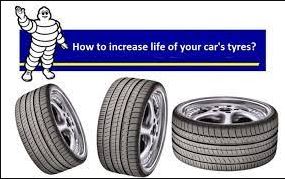
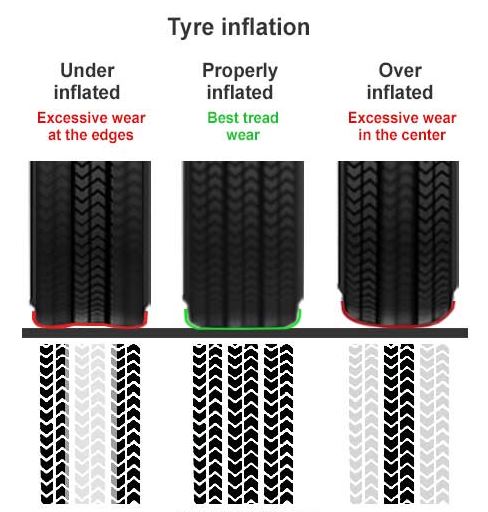
[…] How To Increase Life of the Tyre ? […]